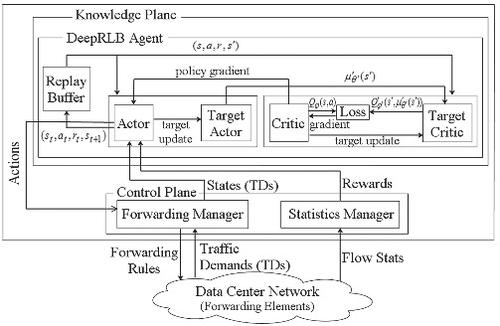当前位置:
X-MOL 学术
›
Int. J. Commun. Syst.
›
论文详情
Our official English website, www.x-mol.net, welcomes your
feedback! (Note: you will need to create a separate account there.)
DeepRLB: A deep reinforcement learning-based load balancing in data center networks
International Journal of Communication Systems ( IF 1.7 ) Pub Date : 2021-08-03 , DOI: 10.1002/dac.4912 Negar Rikhtegar 1 , Omid Bushehrian 1 , Manijeh Keshtgari 1
International Journal of Communication Systems ( IF 1.7 ) Pub Date : 2021-08-03 , DOI: 10.1002/dac.4912 Negar Rikhtegar 1 , Omid Bushehrian 1 , Manijeh Keshtgari 1
Affiliation

|
Data center networks (DCNs) are facing challenging control problems such as flow scheduling, congestion control, load balancing, and bandwidth allocation when dynamically handling heterogeneous mice and elephant flows. This paper focuses on the load balancing in DCNs as an online decision-making problem with high complexity (NP-hard problem). Traditional load balancing approaches are usually the heuristic algorithms relying on the operator's viewpoint and a short-term knowledge of the traffic conditions and network environment. This paper proposes DeepRLB, a deep reinforcement learning (DRL)-based load balancing approach for software-defined networking-based DCNs which exploits the deep deterministic policy gradient (DDPG) algorithm to adaptively learn the link-weight values by observing the traffic flow characteristics. The actor and critic neural networks in the DDPG model have been designed based on two learning models: fully connected (DeepRLB-Full) and convolutional (DeepRLB-Conv). The output of the model is further used by the controller to determine the forwarding paths for traffic flows accordingly. We evaluated the performance of DeepRLB by comparing it with ECMP as well as a per-packet load balancing algorithm in three different data center topologies under 30 heterogeneous traffic demand matrices. The obtained results showed that the DeepRLB algorithm outperforms the ECMP with respect to studied load balancing metrics considerably (DeepRLB-Conv achieved the best performance). As a sample, DeepRLB-Full and DeepRLB-Conv were able to reach 19.14% and 24.46% reduction in the total number of over-utilized and under-utilized network links compared to ECMP, respectively.
中文翻译:

DeepRLB:数据中心网络中基于深度强化学习的负载平衡
数据中心网络 (DCN) 在动态处理异构老鼠流和大象流时面临着具有挑战性的控制问题,例如流量调度、拥塞控制、负载平衡和带宽分配。本文将 DCN 中的负载均衡作为一个高复杂度的在线决策问题(NP-hard 问题)。传统的负载均衡方法通常是依赖于运营商的观点以及对流量状况和网络环境的短期了解的启发式算法。本文提出了 DeepRLB,这是一种基于深度强化学习 (DRL) 的负载平衡方法,用于基于软件定义的网络的 DCN,它利用深度确定性策略梯度 (DDPG) 算法通过观察交通流特征来自适应地学习链路权重值. DDPG模型中的actor和critic神经网络是基于两种学习模型设计的:全连接(DeepRLB-Full)和卷积(DeepRLB-Conv)。控制器进一步使用模型的输出来相应地确定流量的转发路径。我们通过在 30 个异构流量需求矩阵下的三种不同数据中心拓扑中将 DeepRLB 与 ECMP 以及按数据包负载平衡算法进行比较来评估 DeepRLB 的性能。获得的结果表明,DeepRLB 算法在研究的负载平衡指标方面明显优于 ECMP(DeepRLB-Conv 实现了最佳性能)。作为示例,与 ECMP 相比,DeepRLB-Full 和 DeepRLB-Conv 能够将过度使用和未充分利用的网络链接总数减少 19.14% 和 24.46%,
更新日期:2021-09-10
中文翻译:

DeepRLB:数据中心网络中基于深度强化学习的负载平衡
数据中心网络 (DCN) 在动态处理异构老鼠流和大象流时面临着具有挑战性的控制问题,例如流量调度、拥塞控制、负载平衡和带宽分配。本文将 DCN 中的负载均衡作为一个高复杂度的在线决策问题(NP-hard 问题)。传统的负载均衡方法通常是依赖于运营商的观点以及对流量状况和网络环境的短期了解的启发式算法。本文提出了 DeepRLB,这是一种基于深度强化学习 (DRL) 的负载平衡方法,用于基于软件定义的网络的 DCN,它利用深度确定性策略梯度 (DDPG) 算法通过观察交通流特征来自适应地学习链路权重值. DDPG模型中的actor和critic神经网络是基于两种学习模型设计的:全连接(DeepRLB-Full)和卷积(DeepRLB-Conv)。控制器进一步使用模型的输出来相应地确定流量的转发路径。我们通过在 30 个异构流量需求矩阵下的三种不同数据中心拓扑中将 DeepRLB 与 ECMP 以及按数据包负载平衡算法进行比较来评估 DeepRLB 的性能。获得的结果表明,DeepRLB 算法在研究的负载平衡指标方面明显优于 ECMP(DeepRLB-Conv 实现了最佳性能)。作为示例,与 ECMP 相比,DeepRLB-Full 和 DeepRLB-Conv 能够将过度使用和未充分利用的网络链接总数减少 19.14% 和 24.46%,











































 京公网安备 11010802027423号
京公网安备 11010802027423号